大陆裂谷是大陆内部的拉张地带,与地幔软流圈的隆升有关。裂谷作用形成的典型岩石组合为拉斑玄武岩及碱性玄武岩系列,裂谷发育的早期,岩浆来源较深,部分熔融程度较低,以碱性玄武岩为主,岩墙发育;随着裂谷的发展,软流圈进一步上涌,以拉斑玄武岩为主,岩流居多。大陆裂谷带是大陆岩石圈局部拉张伸展的狭长地带,以中心下陷、两边隆起、地壳减薄为特征,常伴有高热流,广泛分布区域性隆起和岩浆作用等现象。其一般的规模为数十里宽,数十至数百千米长,少数裂谷带的范围可达数十万平方千米以上,如美国西部盆岭省,东非裂谷玄武岩也因被视为板块扩张的初始阶段而受学术界重视(Ebinger et al., 1989; Rooney et al., 2007)。
大规模玄武岩浆侵位是大陆裂谷发展的主要特征之一,大陆裂谷的伸展作用有利于幔源岩浆的上涌并在下地壳汇集成岩浆房,大陆裂谷作用是岩石圈拉张断裂和岩浆侵位作用的组合和叠加,岩石圈断裂不仅使幔源岩浆上涌加速,而且为岩浆上涌提供了阻力很小的通道,岩浆侵位伴随岩石圈破裂和热液流体上涌,反过来又促成了大陆裂谷的发育(Pakiser et al., 1990; Richards et al., 2000)。
大陆裂谷的火成岩因常呈对称的水平分布而与岛弧和大陆边缘火成岩弧的极性分布不同,这与洋中脊玄武岩的时空分布类似(邓晋福等,1999)。一般大陆裂谷岩浆特征为:碱性、富含挥发分和大离子亲石元素(LILE),来源于富集地幔。但王金荣等(2016)的研究发现大陆裂谷玄武岩(CRB)、大陆溢流玄武岩(CFB)的源区复杂多样,有强烈富集的,也有亏损的。富集型玄武岩可能来自富集的下地幔,而亏损的玄武岩来自具有大洋中脊玄武岩(MORB)或具有岛弧特征的软流圈地幔,后者表现为明显亏损Nb-Ta的特征。洋岛与大陆裂谷区最显著的是以玄武岩-粗面岩岩石组合为代表的双峰式火成岩组合(Deng,1998; Middlemost,1986),一般认为CRB、CFB其地球化学特征与洋岛玄武岩(OIB)类似,源于富集的下地幔,与地幔柱的活动有关(Wilson,1997)。这三者之间是否存在差别?能否识别?本文对全球新生代CRB数据进行了初步的挖掘,主要与全球OIB进行了初步的对比,发现二者存在许多类似性,也有一定的区别。
1 新生代CRB特征 1.1 数据清洗本文收集了GEOROC数据库全部CRB的地球化学数据共22786件。清新过程如下:
(1) 保留45% < SiO2 < 55%的数据(CRB),计7556件,从上述数据中删去侵入岩、地幔包体、变质岩、沉积岩等的数据,留下的火山岩(包括浅成的辉绿岩等)数据6486件。此外,数据库中还有部分没有主元素但有少量微量元素和同位素的数据,对于这些数据,根据岩石名称一栏,删去所有不是玄武质火山岩的岩石(除辉绿岩外),留下的数据1563件,加入到有SiO2数据中去,总共8049件。
(2) 删去不合理数据。对主量元素删去Al2O3、TiO2、CaO、MgO、P2O5等含量异常高的样品,删去烧失量和H2O>7%和CO2>3%的样品;对微量元素删去含量异常高的数据(但保留该样品)。清洗后剩余数据7969件,为本文研究的基础。
1.2 新生代大陆裂谷玄武岩全球分布特征从图 1看,新生代裂谷玄武岩主要分布在红海口三联点,美国西部盆岭省以及南极洲等地,暗示该区为新生代全球拉张最明显的区域。
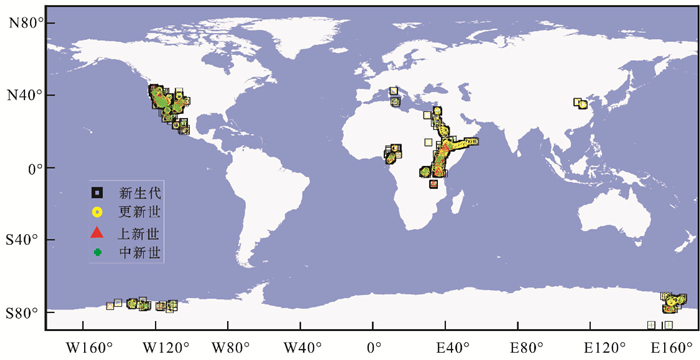
|
图 1 新生代、中新世至更新世裂谷玄武岩分布图 Figure 1 The distribution of the Cenozoic, from Miocene to Pleistocene CRB |
从图 2看,新生代CRB大多出现在更新世时期,其次是中新世和上新世。从全球分布看,更新世裂谷玄武岩最发育,可能暗示更新世是全球拉张最明显的时期,结合中新世时期全球埃达克岩最发育(马珊珊和张旗,待刊),表明新生代时期可能全球中新世挤压最明显,更新世伸展最明显;伸展是挤压后的应力释放。
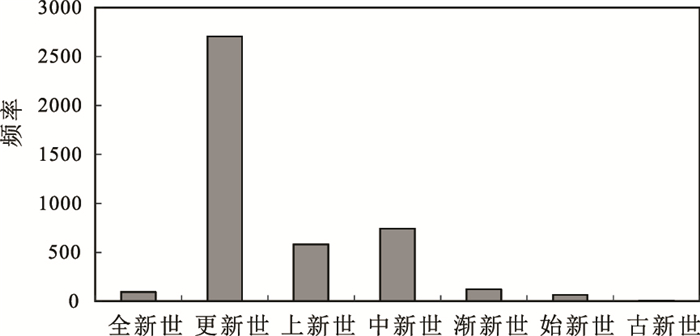
|
图 2 新生代全球裂谷时代分布直方图 Figure 2 The histogram of epochs of the global Cenozoic CRB |
CRB、CFB、OIB之间是否存在差别,能否识别,是一个令人感兴趣的问题。早先的研究认为,CFB、CRB均产于板内构造环境(Middlemost,1986;Deng et al., 1998),其地球化学特征与OIB类似,源于富集的下地幔,与地幔柱活动有关。我们的研究也得到同样的认识:三类玄武岩的地球化学特征比较接近,仅CRB、CFB有一些陆壳物质混染的痕迹(表 1,图 3)。图 3a显示板块内部3类玄武岩的HFSE差别很小,但CRB、CFB的LILE较高,且CFB的Nb-Ta、LREE明显有亏损,推测LREE亏损可能是原始CFB与MORB混合所致。因为大洋盆地各类玄武岩中,唯独MORB亏损LREE,而Nb-Ta亏损可能是混合和陆壳混染两种因素引起的,因为CRB也显示不太明显的Nb-Ta亏损。CRB、CFB明显富集Cs、Pb,而Cs和Pb是陆壳富集的元素(Sun et al., 1989),说明CRB和CFB经历了陆壳混染作用。
|
|
表 1 全球CRB、CFB、OIB主量、微量、稀土元素均值 Table 1 The mean contents of major elements, trace elements and REE of the global CRB, CFB and OIB |

|
球粒陨石标准数据Sun等(1989) 图 3 CRB、CFB和OIB以全球OIB标准化微量元素蛛网图(a)和球粒陨石标准化稀土元素配分图(b) Figure 3 Global OIB-normalized trace element patterns(a) and chondrite-normalized REE patterns(b) of the CRB, CFB and OIB |
火山喷发的熔体的地球化学特征可以反映部分熔融过程,因此主微量元素组成以及稀土元素可以为部分熔融的范围和深度提供信息(Baker et al., 1994; Furman,2007;Shallaly et al., 2013)。图 4显示在石榴子石-尖晶石过渡区域内形成的熔体具有与石榴子石相几乎相同的特征,直到石榴子石完全耗尽(Thirlwall et al., 1994)。而且含石榴子石的源区以明显的MREE高于HREE为特征(Krienitz et al., 2006),与图 3a显示CRB的MREE高于HREE吻合。
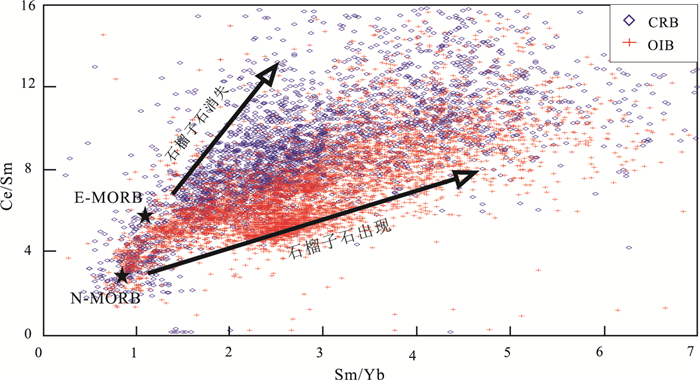
|
地幔部分熔融的载体是石榴子石的出现和消失,箭头指向部分熔融程度更小的方向(Hawkesworth et al., 1994)。N-MORB和E-MORB数据来自Sun和Mcdonough(1989) 图 4 全球CRB、OIB的Ce/Sm-Sm/Yb图 Figure 4 The Ce/Sm vs. Sm/Yb diagram for the global CRB and OIB |
在图 5中,全球CRB大多数分布在Fitton等(1991)提出的OIB范围内,且可以看到大部分CRB具有与OIB相似的La/Nb和La/Ba值,但该图也显示OIB很少有混染的特征,而CRB虽然也是幔源的,但呈明显混染的趋势。
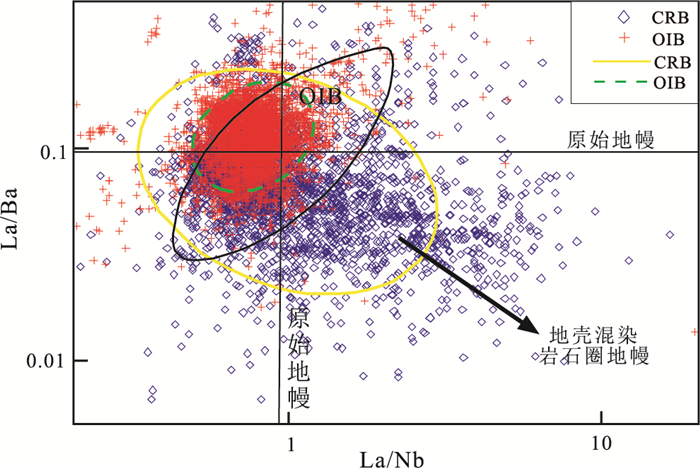
|
原始地幔值据Sun等(1989),黑色圆圈表示OIB范围,据Fitton等(1991)和Fitton(1995) 图 5 全球CRB、OIB的La/Nb-La/Ba图 Figure 5 The La/Nb vs. La/Ba diagram for the global CRB and OIB |
在地幔演化模型中,氦是一种重要的地球化学示踪物。全球OIB的3He/4He(R/RA)(图 6)值显示其有广泛的3He/4He(R为3He/4He测量值,Ra为大气中3He/4He值,为1.4×10-6),Zindler和Hart(2016)在1986年就指出了这一点。由表 1可知,CRB和OIB的3He/4He均值分别为8.12和14.75,相对OIB,CRB则具有较低的3He/4He,且其范围没有OIB广泛。低3He/4He值在一定程度上反映了地壳混染,而高于上地幔均值(8±1 Ra[N-MORB])则表示了有下地幔组成的贡献(Marty et al., 1996)。例如,Bemard等(1993)和Marty等(1996)在研究Afar地幔柱时因其3He/4He值达到20 Ra而认为其来源于地幔深部。高3He/4He值被认为是地幔对流部分的物质的特征,而这些物质为大洋中脊玄武岩(MORB)提供来源(Pik et al., 2006)。
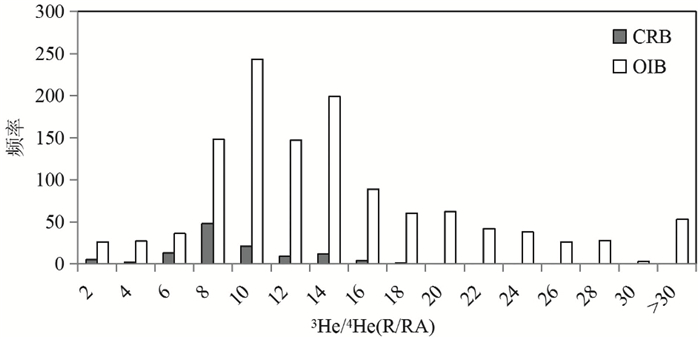
|
图 6 全球CRB、OIB的3He/4He(R/RA)频率分布图 Figure 6 The histogram of frequencies of 3He/4He(R/RA) of global the CRB and OIB |
图 7显示CRB和OIB主要沿石榴子石橄榄岩部分熔融趋势线分布,说明二者具深源特征,是石榴子石橄榄岩部分熔融形成的。且CRB数据点位于OIB之下,说明OIB的源区更深,与3He/4He指示含义一致。

|
石榴子石橄榄岩和尖晶石橄榄岩熔融曲线来自Xu等(2005) 图 7 全球CRB、OIB的La/Yb-Sm/Yb图 Figure 7 The La/Yb vs. Sm/Yb diagram for the global CRB and OIB |
研究表明,CRB与CFB、板内玄武岩(WPB)以及OIB的地球化学特征大体一致,通常是贫Al富Y的(Pearce et al., 1984;王金荣等,2016)。本文研究表明,与OIB和CFB比较,CRB具有更宽的成分变化范围(图 3、5)。据王金荣等(2016)对上述不同构造环境的玄武岩的HFSE研究,CRB的源区可能主要是来自下地幔,是相对富集的。而CFB有趋向于MORB和岛弧的特点,暗示CRB与后两类玄武岩的源区可能有区别,也可能是后两类玄武岩与MORB发生过混合作用或受到过更多的陆壳混染作用的影响。此外,玄武岩地幔源区高度不均一性也可能是一个重要的原因。
大陆裂谷的形成通常与地幔隆升、岩石圈伸展作用有关,有主动裂谷和被动裂谷之分。裂谷作用形成的典型岩石主要为拉斑玄武岩、碱性玄武岩以及与其相伴的中酸性岩组合共同组成的双峰式火山岩系列。在裂谷早期阶段,一般发育以碱性玄武岩为主的岩石组合,随着裂谷的拉伸,软流圈进一步发展,大陆最终被拉开有新洋壳形成时,可形成大量的拉斑玄武岩。裂谷玄武岩的微量元素变化大且复杂。蛛网图中CRB明显富集LILE和亏损HFSE,出现Nb-Ta负异常,暗示玄武岩岩浆源区可能受到来自俯冲带岩石圈的影响(Davis et al., 1995)。埃塞俄比亚Afar低钛玄武岩可能与东非裂谷地幔柱组分中再循环的古老洋壳有关(Barrat et al., 2003);墨西哥古近纪晚期和第四纪裂谷玄武岩,是太平洋板块向东消减时在消减带上盘形成的(Verma and Nelson, 1989; Siebe et al., 2004);加拿大纽芬兰奥陶纪的Wild Bight组火山岩具有岛弧的地球化学痕迹,被认为是在岛弧背景上伸展作用下形成的(Swinden et al., 1990)。长白山火山岩与太平洋板块俯冲和东亚大陆裂谷系密切(樊祺诚等,2007;刘嘉麒等,2015)。因此,许多研究者认为,低钛玄武岩可能是在裂谷阶段受到来自消减带物质的影响(Wallace Carmichael,1992; Davis and Hawkeswort, 1995; Orozco-Esquivel et al., 2007;Köhler et al., 2009),有点类似弧后盆地形成的模式(Verma and Nelson, 1989;West et al., 2004; Gazel et al., 2012)。
CRB与CFB大体类似,但是也存在一些不同(表 1)。主要是,与CRB相比,CFB相对富SiO2,Th/Ta比值略高,这可能与CFB受陆壳混染有关(Best and Christiansen, 2001)。然而CFB的K2O含量并不比CRB高(表 1),可能与CRB部分熔融程度较低有关。此外,CRB略富集LILE和LREE(表 1,图 3),可能也与CRB部分熔融程度较低有关(Best and Christiansen, 2001)。
3.2 陆壳混染的影响蛛网图表明(图 3a),CFB和CRB与OIB比较明显富集Pb,本文认为可能是因为OIB处于洋壳内部,不受陆壳的影响,因而Pb含量较低(Hofmann et al., 1986; Sun and Mcdonough, 1989),而大陆玄武岩很难避免陆壳混染的影响,而陆壳微量元素中最明显的特征之一就是富集Pb(Shinjo et al., 2010)。而对于玄武岩蛛网图中Pb富集和Nb亏损的特征,学术界通常有如下一些解释:(1)来自具有上述地球化学特征的地幔柱(Wilson,1997);(2)来自地幔柱和陆壳的混染(Arndt et al., 1993);(3)OIB与过碱性镁铁质岩浆(钾镁煌斑岩,金伯利岩)的混合,后者来自交代的岩石圈地幔,可能随后还有来自陆壳的混染(Arndt and Christensen, 1992; Gibson et al., 2006; Heinonen et al., 2010);(4)OIB与SCLM(大陆下岩石圈地幔)熔体的混合和随后陆壳的混染;(5)来自富集不相容元素的(如交代的SCLM)浅部源区的熔融或消减带之上的地幔楔的部分熔融(Puffer,2001; De Min et al., 2003; Deckart et al., 2005; Dorais and Tubrett, 2008)。
对恩戈罗恩戈罗火山高地的研究表明,火山爆发期间地壳物质的混染在坦桑尼亚北部和东非裂谷的其他地区都是比较普遍的(Ngorongoro Volcanic Highland-NVH)(Davies and Macdonald 1987; Paslick et al., 1996;Mollel,2007; Mollel et al., 2008;)。从Afar北部(Deniel et al., 1994)到Turkana南部(Furman et al., 2004),地壳混染程度不同,但差别很小。Hart等(1989)通过K/P,Ti/Yb和Sr-Nd同位素研究表明,在11~6 Ma期间,埃塞俄比亚喷发的玄武岩有明显的地壳混染,同时,硅质和玄武质熔体之间的混合也会对裂谷的组成有明显的影响,如在Afar中西部。但是,对于地壳混染是上地壳还是下地壳目前仍是不清楚的(Boccaletti et al., 1995; Chernet and Hart, 1999; Pik et al., 1999; Trua et al., 1999; Kieffer et al., 2004)。
埃塞俄比亚裂谷是受地幔柱影响环境的现代大陆裂谷的典型(Falcon et al., 1970; Girdler,1970; Schilling,1973b),通过对埃塞俄比亚裂谷地幔柱和岩石圈之间的反应,Rooney等(2011)发现,来自深层地幔中不同来源的热点造成的同位素是不均一的,此外,可能也反映了与分离大陆岩石圈的直接混染和混合。
Gao等(2017)对Big Pine Volcanic Field地区的Papoose Canyon(PC)火山岩的研究发现,其斑晶和捕掳体来自比玄武岩演化程度更高的熔体,且在地球化学上比玄武岩更富集LILE。PC玄武岩明显亏损HFSE,其认为可能经历了陆壳混染作用,并提出岩床模型(图 8)来解释。此模型认为,初始熔体脉冲侵入,在地壳内部形成一个或多个岩床。根据对岩床形成压力的研究,这些岩床极有可能在大约20 km处形成,接近地壳的脆性-韧性过渡带(Gazel et al., 2012),地壳内部的岩浆在冷却过程中分离并混染了地壳物质(DePaolo,1981)。
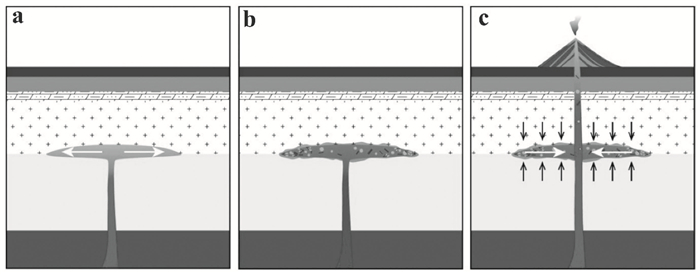
|
(a)一个或多个岩床在爆发之前通过岩浆上冲形成;(b)熔体停留在岩床中,经历结晶和地壳混染;(c)再一次的岩浆上冲导致了喷发。随着火山喷发的推进,由于压力的下降,有斑晶和捕掳体的演化混染岩浆停止,与更原始的熔体混合。据Gao等(2017) 图 8 压缩岩床模型 Figure 8 Deflating sills mode |
(1) 新生代CRB的时空分布表明,CRB绝大部分出现在更新世时期,地域比较集中,主要出现在东非裂谷和盆岭省。更新世裂谷玄武岩最发育,可能暗示更新世是全球拉张最明显的时期,结合中新世时期全球埃达克岩最发育,表明新生代时期可能全球中新世挤压最明显,更新世伸展最明显;伸展是挤压后的应力释放。
(2) 学术界的研究和本文的大数据研究表明,CRB与OIB、CFB的地球化学特征总体上类似。CRB与CFB大体类似,但也存在一些不同,主要是,与CRB相比,CFB相对富SiO2,Th/Ta值略高,表明CRB岩浆受混染比较强烈可能是一个重要的原因。而CRB略富LILE和LREE,可能与CRB部分熔融程度较低有关。
(3) CFB和CRB与OIB比较明显富集Pb,可能是因为OIB处于洋壳内部,不受陆壳的影响,因而Pb含量是较低,而大陆玄武岩很难避免陆壳混染的影响,因为陆壳微量元素中最明显的特征之一就是富集Pb。
(4) 研究表明,CRB的地幔源岩主要为石榴子石橄榄岩,指示其是深源成因的,但OIB的源区深度可能更深一些。因此,CRB的源区深度略浅,混染程度略高,是其区别于OIB的重要特征。
致谢: 成文过程得到中国科学院地质与地球物理研究所张旗研究员、西北大学刘欣雨博士、兰州大学陈万峰博士、潘振杰硕士的指导,在此一并致谢。
| [] | Arndt N T, Christensen U. 1992. The role of lithospheric mantle in continental flood volcanism; thermal and geochemical constraints. Journal of Geophysical Research:Solid Earth, 97(B7): 10967–10981. DOI:10.1029/92JB00564 |
| [] | Arndt N T, Czamanske G K, Wooden J L, Fedorenko V A. 1993. Mantle and crustal contributions to continental flood volcanism. Tectonophysics, 223(1-2): 39–52. DOI:10.1016/0040-1951(93)90156-E |
| [] | Baker M B, Stolper E M. 1994. Determining the composition of high-pressure mantle melts using diamond aggregates. Geochimica et Cosmochimica Acta, 58(13): 2811–2827. DOI:10.1016/0016-7037(94)90116-3 |
| [] | Barrat J A, Joron J L, Taylor R N, Fourcade S, Nesbitt R W, Jahn B M. 2003. Geochemistry of basalts from Manda Hararo, Ethiopia:LREE-depleted basalts in Central Afar. Lithos, 69(1-2): 1–13. DOI:10.1016/S0024-4937(03)00044-6 |
| [] | Bernard M, Irma A, Jean-Alix A B, Catherine D, Pierre V, Philippe V. 1993. He, Ar, Sr, Nd and Pb isotopes in volcanic rocks from Afar:Evidence for a primitive mantle component and constraints on magmatic sources. Geochemical Journal, 27(4-5): 219–228. |
| [] | Best M G, Christiansen E H. 2001. Igneous petrology. MA: Blackwell Science. |
| [] | Boccaletti M, Getaneh A, Mazzuoli R, Tortorici L, Trua T. 1995. Chemical variations in a bimodal magma system:The Plio-Quaternary volcanism in the Dera Nazret area(Main Ethiopian Rift, Ethiopia). Africa Geoscience Review, 2(1): 37–60. |
| [] | Chernet T, Hart W K. 1999. Petrology and geochemistry of volcanism in the northern Main Ethiopian Rift:Southern Afar transition region. Acta Vulcanol, 11(1): 21–41. |
| [] | Davies G R, Macdonald R. 1987. Crustal influence in the petrogenesis of the Naivasha Basalt-Comendite Complex:Combined trace element and Sr-Nd-Pb isotope constraints. Journal of Petrology, 28(6): 1009–1031. DOI:10.1093/petrology/28.6.1009 |
| [] | Davis J M, Hawkesworth C J. 1995. Geochemical and tectonic transitions in the evolution of the Mogollon-Datil Volcanic Field, New Mexico, U.S.A. Chemical Geology, 119(1-4): 31–53. DOI:10.1016/0009-2541(94)00094-O |
| [] | De Min A, Piccirillo E M, Marzoli A, Bellieni G, Renne P R, Ernesto M, Marques L S. 2003. The Central Atlantic Magmatic Province(CAMP)in Brazil:Petrology, Geochemistry, 40Ar/39Ar ages, paleomagnetism and geodynamic implications. In:HAMES, W E, MCHONE J G, RENNE P R, RUPPEL C, eds. The Central Atlantic Magmatic Province:Insights from Fragments of Pangea. Washington:American Geophysical Union, 209-226. |
| [] | Deckart K, Bertrand H, Liégeois J P. 2005. Geochemistry and Sr, Nd, Pb isotopic composition of the Central Atlantic Magmatic Province(CAMP)in Guyana and Guinea. Lithos, 82(3-4): 289–314. DOI:10.1016/j.lithos.2004.09.023 |
| [] | Deng J F. 1998. Trachyte and syenite:Petrogenesis constrained by the petrological phase equilibrium/Proc. Int. Symp. 100-th Anniv. Beijing Univ., Nation Seism. Pub., 1998:745-757 |
| [] | Deniel C, Vidal P, Coulon C, Vellutini P J, Piguet P. 1994. Temporal evolution of mantle sources during continental rifting:The volcanism of Djibouti(Afar). Journal of Geophysical Research:Solid Earth, 99(B2): 2853–2869. DOI:10.1029/93JB02576 |
| [] | Depaolo D J. 1981. Trace element and isotopic effects of combined wall rock assimilation and fractional crystallization. Earth and Planetary Science Letters, 53(2): 189–202. DOI:10.1016/0012-821X(81)90153-9 |
| [] | Dorais M J, Tubrett M. 2008. Identification of a subduction zone component in the Higganum dike, Central Atlantic Magmatic province:A LA-ICPMS study of clinopyroxene with implications for flood basalt petrogenesis. Geochemistry, Geophysics, Geosystems, 9: 10. DOI:10.1029/2008GC002079 |
| [] | Ebinger C J, Bechtel T D, Forsyth D W, Bowin C O. 1989. Effective elastic plate thickness beneath the East African and Afar plateaus and dynamic compensation of the uplifts. Journal of Geophysical Research:Solid Earth, 94(B3): 2883–2901. DOI:10.1029/JB094iB03p02883 |
| [] | Falcon N L, Gass I G, Girdler R W, Laughton A S. 1970. A discussion on the structure and evolution of the Red Sea and the nature of the Red Sea, Gulf of Aden, and Ethiopia Rift Junction. Philosophical Transactions of the Royal Society of London, Series A, 267: 131–142. DOI:10.1098/rsta.1970.0028 |
| [] | Fitton J G. 1995. Coupled molybdenum and niobium depletion in continental basalts. Earth and Planetary Science Letters, 136(3-4): 715–721. DOI:10.1016/0012-821X(95)00171-8 |
| [] | Fitton J G, James D, Leeman W P. 1991. Basic magmatism associated with the late Cenozoic ex tension in the western United States:Compositional variations in space and time. Journal of Geophysical Research:Solid Earth, 96(B8): 13693–13711. DOI:10.1029/91JB00372 |
| [] | Furman T. 2007. Geochemistry of East African Rift basalts:An overview. Journal of African Earth Sciences, 48(2-3): 147–160. DOI:10.1016/j.jafrearsci.2006.06.009 |
| [] | Furman T, Bryce J G, Karson J, Iotti A. 2004. East African Rift System(EARS)plume structure:Insights from Quaternary mafic lavas of Turkana, Kenya. Journal of Petrology, 2004, 45(5): 1069–1088. |
| [] | Gao R H, Lassiter J C, Ramirez G. 2017. Origin of temporal compositional trends in monogenetic vent eruptions:Insights from the crystal cargo in the Papoose Canyon sequence, Big Pine Volcanic Field, CA. Earth and Planetary Science Letters, 457: 227–237. DOI:10.1016/j.epsl.2016.10.013 |
| [] | Gazel E, Plank T, Forsyth D W, Bendersky C, Lee C T A, Hauri E H. 2012. Litho-sphere versus asthenosphere mantle sources at the Big Pine Volcanic Field, California. Geochemistry, Geophysics, Geosystems, 13(6): Q0AK06. |
| [] | Gibson S A, Thompson R N, Day J A. 2006. Timescales and mechanisms of plume-lithosphere interactions:40Ar/39Ar geochronology and geochemistry of alkaline igneous rocks from the Parana-Etendeka large igneous province. Earth and Planetary Science Letters, 251(1-2): 1–17. DOI:10.1016/j.epsl.2006.08.004 |
| [] | Girdler R W. 1970. A review of the Red Sea heat flow. Philosophical Transactions of the Royal Society of London, Series A, 267: 191–204. DOI:10.1098/rsta.1970.0032 |
| [] | Hart W K, Woldegabriel G, Walter R C, Mertzman S A. 1989. Basaltic volcanism in Ethiopia:Constraints on continental rifting and mantle interactions. Journal of Geophysical Research:Solid Earth, 94(B6): 7731–7748. DOI:10.1029/JB094iB06p07731 |
| [] | Hawkesworth C J, Gallager K, Hergt J M, Mcdermott F. 1994. Destructive plate margin magmatism:Geochemistry and melt generation. Lithos, 33(1-3): 169–188. DOI:10.1016/0024-4937(94)90059-0 |
| [] | Heinonen J S, Carlson R W, Luttinen A V. 2010. Isotopic(Sr, Nd, Pb, and Os)composition of highly magnesian dykes of Vestfjella, western Dronning Maud Land, Antarctica:A key to the origins of the Jurassic Karoo large igneous province. Chemical Geology, 277(3-4): 227–244. DOI:10.1016/j.chemgeo.2010.08.004 |
| [] | Hofmann A W, Jochum K P, Seufert M, White W M. 1986. Nb and Pb in oceanic basalts:New constraints on mantle evolution. Earth and Planetary Science Letters, 79(1-2): 33–45. DOI:10.1016/0012-821X(86)90038-5 |
| [] | Kieffer B, Arndt N, Lapierre H, Bastien F, Bosch D, Pecher A, Yirgu G, Ayalew D, Weis D, Jerram D A, Keller F, Meugniot C. 2004. Flood and shield basalts from Ethiopia:Magmas from the African superswell. Journal of Petrology, 2004, 45(4): 793–834. |
| [] | Köhler J, Schönenberger J, Upton B, Markl G. 2009. Halogen and trace-element chemistry in the Gardar Province, South Greenland:Subduction-related mantle metasomatism and fluid exsolution from alkalic melts. Lithos, 113(3-4): 731–747. DOI:10.1016/j.lithos.2009.07.004 |
| [] | Krienitz M S, Haase K M, Mezger K, Eckardt V, Shaikh-Mashail M A. 2006. Magma genesis and crustal contamination of continental intraplate lavas in Northwestern Syria. Contributions to Mineralogy and Petrology, 151(6): 698–716. DOI:10.1007/s00410-006-0088-1 |
| [] | Marty B, Pik R Ï, Yirgu G. 1996. Helium isotopic variations in Ethiopian plume lavas:Nature of magmatic sources and limit on lower mantle contribution. Earth and Planetary Science Letters, 144(1-2): 223–237. DOI:10.1016/0012-821X(96)00158-6 |
| [] | Middlemost E A K. 1986. Magmas and magmatic rocks:An introduction to igneous petrology. London, New York:Longman, 257. |
| [] | Mollel G F. 2007. Petrochemistry and Geochronology of Ngorongoro Volcanic Highland Complex(NVHC)and its relationship to Laetoli and Olduvai Gorge, Tanzania. New Brunswick:Rutgers University. |
| [] | Mollel G F, Swisher C C, Feigenson M D, Carr M J. 2008. Geochemical evolution of Ngorongoro caldera, northern Tanzania:Implications for crust-magma interaction. Earth and Planetary Science Letters, 271(1-4): 337–347. DOI:10.1016/j.epsl.2008.04.014 |
| [] | Orozco-Esquivel T, Petrone C M, Ferrari L, Tagami T, Manetti P. 2007. Geochemical and isotopic variability in lavas from the eastern Trans-Mexican Volcanic Belt:Slab detachment in a subduction zone with varying dip. Lithos, 93(1-2): 149–174. DOI:10.1016/j.lithos.2006.06.006 |
| [] | Pakiser L C, Mooney W D. 1990. Geophysical Framework of the Continental United States. Geological Society of America. |
| [] | Paslick C, Halliday A N, Lange R A, James D, Dawson J B. 1996. Indirect crustal contamination:Evidence from isotopic and chemical disequilibria in minerals from alkali basalts and Nephelinites from northern Tanzania. Contributions to Mineralogy and Petrology, 125(4): 277–292. DOI:10.1007/s004100050222 |
| [] | Pearce J A, Lippard S J, Roberts S. 1984. Characteristics and tectonic significance of supra-subduction zone ophiolites.In:Gass I G, Lippard S J, Shelton A W eds. Ophiolites and Oceanic Lithosphere.. Geological Society, London, Special Publications, 16: 77–94. DOI:10.1144/GSL.SP.1984.016.01.06 |
| [] | Pik R, Deniel C, Coulon C, Yirgu G, Marty B. 1999. Isotopic and trace element signatures of Ethiopian flood basalts:Evidence for plume-lithosphere interactions. Geochimica et Cosmochimica Acta, 63(15): 2263–2279. DOI:10.1016/S0016-7037(99)00141-6 |
| [] | Pik R, Marty B, Hilton D R. 2006. How many mantle plumes in Africa? The geochemical point of view. Chemical Geology, 226(3): 100–114. |
| [] | Puffer J H. 2001. Contrasting HFSE contents of plume sourced and reactivated arc-sourced continental flood basalts. Geology, 29: 675–678. DOI:10.1130/0091-7613(2001)029<0675:CHFSEC>2.0.CO;2 |
| [] | Richards M A, Gordon R G, Van Der Hilst. 2000. The history and dynamics of global plate motions. Washington DC:AGU. |
| [] | Rooney T, Furman T, Bastow I, Ayalew D, Yirgu G. 2007. Lithospheric modification during crustal extension in the Main Ethiopian Rift. Journal of Geophysical Research:Solid Earth, 112(B10): B10201. DOI:10.1029/2006JB004916 |
| [] | Rooney T O, Hanan B B, Graham D W, Furman T, Blichert-Toft J, Schilling J G. 2011. Permian mantle pollution during Afar plume-continental rift interaction. Journal of Petrology, 53(2): 365–389. |
| [] | Schilling J G. 1973. Afar Mantle Plume:Rare earth evidence. Nature, Physical Science, 242(114): 2–5. DOI:10.1038/physci242002a0 |
| [] | Shallaly N A, Beier C, Haase K M, Hammed M S. 2013. Petrology and geochemistry of the Tertiary Suez rift volcanism, Sinai, Egypt. Journal of Volcanology and Geothermal Research, 267: 119–137. DOI:10.1016/j.jvolgeores.2013.10.005 |
| [] | Shinjo R, Chekol T, Meshesha D, Itaya T, Tatsumi Y. 2011. Geochemistry and geochronology of the mafic lavas from the southeastern Ethiopian rift(the East African Rift System):Assessment of models on magma sources, plume-lithosphere interaction and plume evolution. Contributions to Mineralogy and Petrology, 162(1): 209–230. DOI:10.1007/s00410-010-0591-2 |
| [] | Sun S S, Mcdonough W F. 1989. Chemical and isotopic systematics of oceanic basalts:Implications for mantle composition and processes. In:Saunders A D, Norry M J, Eds. Magmatism in the Oceanic Basins:Geological Society Special Publication, 42:313-345 |
| [] | Swinden H S, Jenner G A, Fryer B J, Hertogen J, Roddick J C. 1990. Petrogenesis and paleotectonic history of the Wild Bight Group, an Ordovician rifted island arc in central Newfoundland. Contributions to Mineralogy and Petrology, 105(2): 219–241. DOI:10.1007/BF00678987 |
| [] | Thirlwall F M, Upton B G J, Jenkins C. 1994. Interaction between continental lithosphere and the Iceland plume-SrNdPb isotope geochemistry of Tertiary basalts, NE Greenland. Journal of Petrology, 35(3): 839–879. DOI:10.1093/petrology/35.3.839 |
| [] | Trua T, Deniel C, Mazzuoli R. 1999. Crustal control in the genesis of Plio-Quaternary bimodal magmatism of the Main Ethiopian Rift(MER):Geochemical and isotopic(Sr, Nd, Pb)evidence. Chemical Geology, 155(3-4): 201–231. DOI:10.1016/S0009-2541(98)00174-0 |
| [] | Verma S P, Nelson S A. 1989. Isotopic and trace element constraints on the origin and evolution of alkaline and calc-alkaline magmas in the Northwestern Mexican Volcanic Belt. Journal of Geophysical Research:Solid Earth, 94(B4): 4531–4544. DOI:10.1029/JB094iB04p04531 |
| [] | Wallace P, Carmichael S E. 1992. Alkaline and calc-alkaline lavas near Los Volcanes, Jalisco, Mexico:Geochemical diversity and its significance in volcanic arcs. Contributions to Mineralogy and Petrology, 111(4): 423–439. DOI:10.1007/BF00320899 |
| [] | West D P, Coish R A, Tomascak P B. 2004. Tectonic setting and regional correlation of Ordovician metavolcanic rocks of the Casco Bay Group, Maine:Evidence from trace element and isotope geochemistry. Geological Magazine, 141(2): 125–140. DOI:10.1017/S0016756803008562 |
| [] | Wilson M. 1997. Thermal evolution of the Central Atlantic passive margins:Continental break-up above a Mesozoic super-plume. Journal of Geological Society, 154: 491–495. DOI:10.1144/gsjgs.154.3.0491 |
| [] | Xu Y G, Ma J L, Frey F A, Feigenson M D, Liu J F. 2005. Role of lithosphere-asthenosphere interaction in the genesis of Quaternary alkali and tholeiitic basalts from Datong, western North China Carton. Chemical Geology, 224(4): 247–271. DOI:10.1016/j.chemgeo.2005.08.004 |
| [] | Zindler A, Hart S R. 1986. Chemical Geodynamics. Annual Review of Earth and Planetary Sciences, 14: 493–571. DOI:10.1146/annurev.ea.14.050186.002425 |
| [] | 安屹, 杨婧, 陈万峰, 王金荣, 张旗, 潘振杰, 焦守涛. 2017. N-MORB、E-MORB和OIB的区别及其可能的原因:大数据的启示. 地质科学, 52(3): 727–742. DOI:10.12017/dzkx.2017.046 |
| [] | 邓晋福, 莫宣学, 罗照华, 赵海玲, 赵国, 曹永清, 于学政. 1999. 火成岩构造组合与壳-幔成矿系统. 地学前缘, 6(2): 259–270. |
| [] | 樊祺诚, 隋建立, 李霓, 孙谦, 徐义刚. 2007. 长白山天池火山双岩浆房岩浆作用与互动式喷发. 矿物岩石地球化学通报, 26(4): 315–318. |
| [] | 刘嘉麒, 陈双双, 郭文峰, 孙春青, 张茂亮, 郭正府. 2015. 长白山火山研究进展. 矿物岩石地球化学通报, 34(4): 710–723. |
| [] | 马珊珊, 张旗. 2017. 中新世的巨型欧亚高原:埃达克岩的证据. 矿物岩石地球化学通报,. |
| [] | 王金荣, 潘振杰, 张旗, 陈万峰, 杨婧, 焦守涛, 王淑华. 2016. 大陆板内玄武岩数据挖掘:成分多样性及在判别图中的表现. 岩石学报, 32(7): 1919–1933. |
 2017, Vol. 36
2017, Vol. 36


